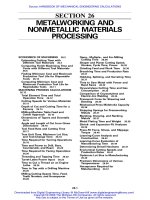Engineering Statistics Handbook Episode 8 Part 6 potx
Bạn đang xem bản rút gọn của tài liệu. Xem và tải ngay bản đầy đủ của tài liệu tại đây (73.76 KB, 15 trang )
5.39 0 3 0.49 2.64
5.09 0 4 0.77 3.92
4.31 1 4 0.68 2.93
4.19 0 5 0.96 4.02
3.60 1 6 1.16 4.17
3.26 1 8 1.68 5.47
2.96 2 10 2.27 6.72
2.77 3 11 2.46 6.82
2.62 4 13 3.07 8.05
2.46 4 14 3.29 8.11
2.21 3 15 3.41 7.55
1.97 4 20 4.75 9.35
1.74 6 30 7.45 12.96
Example
Example of
a double
sampling
plan
We wish to construct a double sampling plan according to
p
1
= 0.01 = 0.05 p
2
= 0.05 = 0.10 and n
1
= n
2
The plans in the corresponding table are indexed on the ratio
R = p
2
/p
1
= 5
We find the row whose R is closet to 5. This is the 5th row (R = 4.65). This
gives c
1
= 2 and c
2
= 4. The value of n
1
is determined from either of the two
columns labeled pn
1
.
The left holds
constant at 0.05 (P = 0.95 = 1 - ) and the right holds
constant at 0.10. (P = 0.10). Then holding constant we find pn
1
= 1.16 so n
1
= 1.16/p
1
= 116. And, holding constant we find pn
1
= 5.39, so n
1
= 5.39/p
2
=
108. Thus the desired sampling plan is
n
1
= 108 c
1
= 2 n
2
= 108 c
2
= 4
If we opt for n
2
= 2n
1
, and follow the same procedure using the appropriate
table, the plan is:
n
1
= 77 c
1
= 1 n
2
= 154 c
2
= 4
The first plan needs less samples if the number of defectives in sample 1 is
greater than 2, while the second plan needs less samples if the number of
defectives in sample 1 is less than 2.
ASN Curve for a Double Sampling Plan
6.2.4. What is Double Sampling?
(3 of 5) [5/1/2006 10:34:47 AM]
Construction
of the ASN
curve
Since when using a double sampling plan the sample size depends on whether
or not a second sample is required, an important consideration for this kind of
sampling is the Average Sample Number (ASN) curve. This curve plots the
ASN versus p', the true fraction defective in an incoming lot.
We will illustrate how to calculate the ASN curve with an example. Consider a
double-sampling plan n
1
= 50, c
1
= 2, n
2
= 100, c
2
= 6, where n
1
is the sample
size for plan 1, with accept number c
1
, and n
2
, c
2
, are the sample size and
accept number, respectively, for plan 2.
Let p' = .06. Then the probability of acceptance on the first sample, which is the
chance of getting two or less defectives, is .416 (using binomial tables). The
probability of rejection on the second sample, which is the chance of getting
more than six defectives, is (1 971) = .029. The probability of making a
decision on the first sample is .445, equal to the sum of .416 and .029. With
complete inspection of the second sample, the average size sample is equal to
the size of the first sample times the probability that there will be only one
sample plus the size of the combined samples times the probability that a
second sample will be necessary. For the sampling plan under consideration,
the ASN with complete inspection of the second sample for a p' of .06 is
50(.445) + 150(.555) = 106
The general formula for an average sample number curve of a double-sampling
plan with complete inspection of the second sample is
ASN = n
1
P
1
+ (n
1
+ n
2
)(1 - P
1
) = n
1
+ n
2
(1 - P
1
)
where P
1
is the probability of a decision on the first sample. The graph below
shows a plot of the ASN versus p'.
The ASN
curve for a
double
sampling
plan
6.2.4. What is Double Sampling?
(4 of 5) [5/1/2006 10:34:47 AM]
6.2.4. What is Double Sampling?
(5 of 5) [5/1/2006 10:34:47 AM]
6.2.5. What is Multiple Sampling?
(2 of 2) [5/1/2006 10:34:48 AM]
Description
of
sequentail
sampling
graph
The cumulative observed number of defectives is plotted on the graph.
For each point, the x-axis is the total number of items thus far selected,
and the y-axis is the total number of observed defectives. If the plotted
point falls within the parallel lines the process continues by drawing
another sample. As soon as a point falls on or above the upper line, the
lot is rejected. And when a point falls on or below the lower line, the lot
is accepted. The process can theoretically last until the lot is 100%
inspected. However, as a rule of thumb, sequential-sampling plans are
truncated after the number inspected reaches three times the number that
would have been inspected using a corresponding single sampling plan.
Equations
for the limit
lines
The equations for the two limit lines are functions of the parameters p
1
,
, p
2
, and .
where
Instead of using the graph to determine the fate of the lot, one can resort
to generating tables (with the help of a computer program).
Example of
a sequential
sampling
plan
As an example, let p
1
= .01, p
2
= .10, = .05, = .10. The resulting
equations are
Both acceptance numbers and rejection numbers must be integers. The
acceptance number is the next integer less than or equal to x
a
and the
rejection number is the next integer greater than or equal to x
r
. Thus for
n = 1, the acceptance number = -1, which is impossible, and the
rejection number = 2, which is also impossible. For n = 24, the
acceptance number is 0 and the rejection number = 3.
The results for n =1, 2, 3 26 are tabulated below.
6.2.6. What is a Sequential Sampling Plan?
(2 of 3) [5/1/2006 10:34:48 AM]
n
inspect
n
accept
n
reject
n
inspect
n
accept
n
reject
1 x x 14 x 2
2 x 2 15 x 2
3 x 2 16 x 3
4 x 2 17 x 3
5 x 2 18 x 3
6 x 2 19 x 3
7 x 2 20 x 3
8 x 2 21 x 3
9 x 2 22 x 3
10 x 2 23 x 3
11 x 2 24 0 3
12 x 2 25 0 3
13 x 2 26 0 3
So, for n = 24 the acceptance number is 0 and the rejection number is 3.
The "x" means that acceptance or rejection is not possible.
Other sequential plans are given below.
n
inspect
n
accept
n
reject
49 1 3
58 1 4
74 2 4
83 2 5
100 3 5
109 3 6
The corresponding single sampling plan is (52,2) and double sampling
plan is (21,0), (21,1).
Efficiency
measured by
ASN
Efficiency for a sequential sampling scheme is measured by the average
sample number (ASN) required for a given Type I and Type II set of
errors. The number of samples needed when following a sequential
sampling scheme may vary from trial to trial, and the ASN represents the
average of what might happen over many trials with a fixed incoming
defect level. Good software for designing sequential sampling schemes
will calculate the ASN curve as a function of the incoming defect level.
6.2.6. What is a Sequential Sampling Plan?
(3 of 3) [5/1/2006 10:34:48 AM]
Illustration of
a skip lot
sampling plan
An illustration of a a skip-lot sampling plan is given below.
ASN of skip-lot
sampling plan
An important property of skip-lot sampling plans is the average sample number
(ASN ). The ASN of a skip-lot sampling plan is
ASN
skip-lot
= (F)(ASN
reference
)
where F is defined by
Therefore, since 0 < F < 1, it follows that the ASN of skip-lot sampling is
smaller than the ASN of the reference sampling plan.
In summary, skip-lot sampling is preferred when the quality of the submitted
lots is excellent and the supplier can demonstrate a proven track record.
6.2.7. What is Skip Lot Sampling?
(2 of 2) [5/1/2006 10:34:49 AM]
6. Process or Product Monitoring and Control
6.3. Univariate and Multivariate Control Charts
6.3.1.What are Control Charts?
Comparison of
univariate and
multivariate
control data
Control charts are used to routinely monitor quality. Depending on the
number of process characteristics to be monitored, there are two basic
types of control charts. The first, referred to as a univariate control
chart, is a graphical display (chart) of one quality characteristic. The
second, referred to as a multivariate control chart, is a graphical
display of a statistic that summarizes or represents more than one
quality characteristic.
Characteristics
of control
charts
If a single quality characteristic has been measured or computed from
a sample, the control chart shows the value of the quality characteristic
versus the sample number or versus time. In general, the chart contains
a center line that represents the mean value for the in-control process.
Two other horizontal lines, called the upper control limit (UCL) and
the lower control limit (LCL), are also shown on the chart. These
control limits are chosen so that almost all of the data points will fall
within these limits as long as the process remains in-control. The
figure below illustrates this.
Chart
demonstrating
basis of
control chart
6.3.1. What are Control Charts?
(1 of 4) [5/1/2006 10:34:49 AM]
Why control
charts "work"
The control limits as pictured in the graph might be .001 probability
limits. If so, and if chance causes alone were present, the probability of
a point falling above the upper limit would be one out of a thousand,
and similarly, a point falling below the lower limit would be one out of
a thousand. We would be searching for an assignable cause if a point
would fall outside these limits. Where we put these limits will
determine the risk of undertaking such a search when in reality there is
no assignable cause for variation.
Since two out of a thousand is a very small risk, the 0.001 limits may
be said to give practical assurances that, if a point falls outside these
limits, the variation was caused be an assignable cause. It must be
noted that two out of one thousand is a purely arbitrary number. There
is no reason why it could have been set to one out a hundred or even
larger. The decision would depend on the amount of risk the
management of the quality control program is willing to take. In
general (in the world of quality control) it is customary to use limits
that approximate the 0.002 standard.
Letting X denote the value of a process characteristic, if the system of
chance causes generates a variation in X that follows the normal
distribution, the 0.001 probability limits will be very close to the 3
limits. From normal tables we glean that the 3 in one direction is
0.00135, or in both directions 0.0027. For normal distributions,
therefore, the 3
limits are the practical equivalent of 0.001
probability limits.
6.3.1. What are Control Charts?
(2 of 4) [5/1/2006 10:34:49 AM]
Plus or minus
"3 sigma"
limits are
typical
In the U.S., whether X is normally distributed or not, it is an acceptable
practice to base the control limits upon a multiple of the standard
deviation. Usually this multiple is 3 and thus the limits are called
3-sigma limits. This term is used whether the standard deviation is the
universe or population parameter, or some estimate thereof, or simply
a "standard value" for control chart purposes. It should be inferred
from the context what standard deviation is involved. (Note that in the
U.K., statisticians generally prefer to adhere to probability limits.)
If the underlying distribution is skewed, say in the positive direction,
the 3-sigma limit will fall short of the upper 0.001 limit, while the
lower 3-sigma limit will fall below the 0.001 limit. This situation
means that the risk of looking for assignable causes of positive
variation when none exists will be greater than one out of a thousand.
But the risk of searching for an assignable cause of negative variation,
when none exists, will be reduced. The net result, however, will be an
increase in the risk of a chance variation beyond the control limits.
How much this risk will be increased will depend on the degree of
skewness.
If variation in quality follows a Poisson distribution, for example, for
which np = .8, the risk of exceeding the upper limit by chance would
be raised by the use of 3-sigma limits from 0.001 to 0.009 and the
lower limit reduces from 0.001 to 0. For a Poisson distribution the
mean and variance both equal np. Hence the upper 3-sigma limit is 0.8
+ 3 sqrt(.8) = 3.48 and the lower limit = 0 (here sqrt denotes "square
root"). For np = .8 the probability of getting more than 3 successes =
0.009.
Strategies for
dealing with
out-of-control
findings
If a data point falls outside the control limits, we assume that the
process is probably out of control and that an investigation is
warranted to find and eliminate the cause or causes.
Does this mean that when all points fall within the limits, the process is
in control? Not necessarily. If the plot looks non-random, that is, if the
points exhibit some form of systematic behavior, there is still
something wrong. For example, if the first 25 of 30 points fall above
the center line and the last 5 fall below the center line, we would wish
to know why this is so. Statistical methods to detect sequences or
nonrandom patterns can be applied to the interpretation of control
charts. To be sure, "in control" implies that all points are between the
control limits and they form a random pattern.
6.3.1. What are Control Charts?
(3 of 4) [5/1/2006 10:34:49 AM]
6.3.1. What are Control Charts?
(4 of 4) [5/1/2006 10:34:49 AM]
Sample
Variance
If
2
is the unknown variance of a probability distribution, then an
unbiased estimator of
2
is the sample variance
However, s, the sample standard deviation is not an unbiased estimator
of
. If the underlying distribution is normal, then s actually estimates
c
4
, where c
4
is a constant that depends on the sample size n. This
constant is tabulated in most text books on statistical quality control
and may be calculated using
C
4
factor
To compute this we need a non-integer factorial, which is defined for
n/2 as follows:
Fractional
Factorials
With this definition the reader should have no problem verifying that
the c
4
factor for n = 10 is .9727.
6.3.2. What are Variables Control Charts?
(2 of 5) [5/1/2006 10:34:50 AM]
Mean and
standard
deviation of
the
estimators
So the mean or expected value of the sample standard deviation is c
4
.
The standard deviation of the sample standard deviation is
What are the differences between control limits and specification
limits ?
Control
limits vs.
specifications
Control Limits are used to determine if the process is in a state of
statistical control (i.e., is producing consistent output).
Specification Limits are used to determine if the product will function
in the intended fashion.
How many data points are needed to set up a control chart?
How many
samples are
needed?
Shewhart gave the following rule of thumb:
"It has also been observed that a person would seldom if
ever be justified in concluding that a state of statistical
control of a given repetitive operation or production
process has been reached until he had obtained, under
presumably the same essential conditions, a sequence of
not less than twenty five samples of size four that are in
control."
It is important to note that control chart properties, such as false alarm
probabilities, are generally given under the assumption that the
parameters, such as
and , are known. When the control limits are
not computed from a large amount of data, the actual properties might
be quite different from what is assumed (see, e.g., Quesenberry, 1993).
When do we recalculate control limits?
6.3.2. What are Variables Control Charts?
(3 of 5) [5/1/2006 10:34:50 AM]
When do we
recalculate
control
limits?
Since a control chart "compares" the current performance of the
process characteristic to the past performance of this characteristic,
changing the control limits frequently would negate any usefulness.
So, only change your control limits if you have a valid, compelling
reason for doing so. Some examples of reasons:
When you have at least 30 more data points to add to the chart
and there have been no known changes to the process
- you get a better estimate of the variability
●
If a major process change occurs and affects the way your
process runs.
●
If a known, preventable act changes the way the tool or process
would behave (power goes out, consumable is corrupted or bad
quality, etc.)
●
What are the WECO rules for signaling "Out of Control"?
General
rules for
detecting out
of control or
non-random
situaltions
WECO stands for Western Electric Company Rules
Any Point Above +3 Sigma
+3
LIMIT
2 Out of the Last 3 Points Above +2 Sigma
+2
LIMIT
4 Out of the Last 5 Points Above +1 Sigma
+1
LIMIT
8 Consecutive Points on This Side of Control Line
=================================== CENTER LINE
8 Consecutive Points on This Side of Control Line
-1
LIMIT
4 Out of the Last 5 Points Below - 1 Sigma
-2
LIMIT
2 Out of the Last 3 Points Below -2 Sigma
-3
LIMIT
Any Point Below -3 Sigma
Trend Rules: 6 in a row trending up or down. 14 in a row alternating
up and down
6.3.2. What are Variables Control Charts?
(4 of 5) [5/1/2006 10:34:50 AM]
WECO rules
based on
probabilities
The WECO rules are based on probability. We know that, for a normal
distribution, the probability of encountering a point outside ± 3
is
0.3%. This is a rare event. Therefore, if we observe a point outside the
control limits, we conclude the process has shifted and is unstable.
Similarly, we can identify other events that are equally rare and use
them as flags for instability. The probability of observing two points
out of three in a row between 2
and 3 and the probability of
observing four points out of five in a row between 1
and 2 are also
about 0.3%.
WECO rules
increase
false alarms
Note: While the WECO rules increase a Shewhart chart's sensitivity to
trends or drifts in the mean, there is a severe downside to adding the
WECO rules to an ordinary Shewhart control chart that the user should
understand. When following the standard Shewhart "out of control"
rule (i.e., signal if and only if you see a point beyond the plus or minus
3 sigma control limits) you will have "false alarms" every 371 points
on the average (see the description of Average Run Length or ARL on
the next page). Adding the WECO rules increases the frequency of
false alarms to about once in every 91.75 points, on the average (see
Champ and Woodall, 1987). The user has to decide whether this price
is worth paying (some users add the WECO rules, but take them "less
seriously" in terms of the effort put into troubleshooting activities when
out of control signals occur).
With this background, the next page will describe how to construct
Shewhart variables control charts.
6.3.2. What are Variables Control Charts?
(5 of 5) [5/1/2006 10:34:50 AM]









